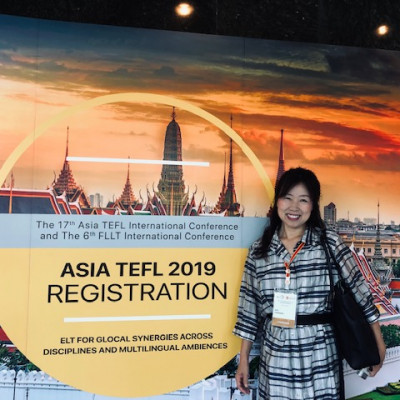Sessions / Location Name: Room 11
Virtual Location
Virtual: You cannot enter virtually via this page. Click on the titles of individual presentations or go to the Live Page
Benefits of Using Multiple Representations to Low L2 Proficiency Learners #2242
Generally, authentic materials are considered difficult for low L2 proficiency learners. The study found that when L2 learners engage in connected learning by watching multimedia videos and reading texts of the relevant topic together, and the content is meaningful to them, they perceive authentic content learning positively. In this presentation, I will share relevant research and some participants' responses to show how deeply they were able to learn TED Talk ideas through connected learning.
Creating High-Quality Listening Materials #2112
This workshop will explain and demonstrate the process of creating high-quality listening materials for classroom use, textbook audio, or online education. Participants will become familiar with the basic equipment and software, as well as how to record, edit and share audio of a high quality.
In Quest of the Optimal Way of Using Grammarly for College Writing Tasks #2151
There is a growing interest in using automatic grammar checkers for English language teaching. To find the optimal way of using machine corrective feedback, the researcher experimented with 75 second-year university students. They received three types of feedback: machine feedback by Grammarly, indirect written feedback with marking, and direct written feedback with correct forms. Students’ views collected through a post-questionnaire suggested the complementary use of Grammarly could raise students’ satisfaction levels while lowering teachers’ burden.
What We Know About Teachers’ Medium of Instruction in Remote Learning #1960
English instructors in Japanese universities hold differing principles regarding the amount of Japanese and English that they use in the classroom. In 2020, these principles were tested for many teachers when classes shifted online. The present study aimed to learn how distance learning affects teachers’ medium of instruction through interviews and observations of Zoom lessons. Findings indicate that technology poses problems as well as offers new opportunities to English instructors.
Dual Theoretical Approach to Summary Writing Instruction Using SFL and LCT #2049
サマリーライティングの効果的な指導・評価・フィードバックには理論的枠組に基づく抽象的概念を使うことが有効だ。ここでは選択体系機能言語学(SFL)のジャンル、および社会学の正当化コード理論(LCT)における意味の波の概念を学習者に合わせて再定義した概念を使った英語読解指導を紹介し、その成果と応用可能性を議論する。
Acclimating Japanese Learners of English to Some Asian English Accents #2172
Recently, Japanese speakers of English have increasingly more chances to communicate with Asian people in English. Research shows that when listeners become familiarized with certain accents with explicit instruction on the pronunciation characteristics, they comprehend the accented English better and are more willing to communicate. This presentation will demonstrate how teachers can use a Web-based material jointly developed by two universities to acclimate students to the pronunciation characteristics of Singaporean, Indian, Philippine, and Malaysian English.
Art and Artists in the EFL Classroom #2323
This presentation discusses the use of artworks as teaching materials in the EFL classroom. Students at a Japanese art university participated in the study over three semesters. Qualitative data was collected through student essays and participatory responses, suggesting that narrative representational paintings increased student participation, engagement, and motivation. Improvement in vocabulary acquisition and descriptive writing was also noted. The study was motivated by curiosity about the visual arts and their possible roles in EFL.
The Impact of Assistant Language Teachers on English Education in Shizuoka #2285
To the best of the presenter’s knowledge, no studies (in English) have been found on ALTs specific impacts at the prefectural level concerning English language outcomes in Shizuoka. The study’s findings showed that teaching methods continue to be influenced by traditional teaching methods; however, there is some effort to integrate more communicative approaches. For more positive impacts, there is a need for clarity across schools about ALTs’ job roles and functions.
Effects of Form-Focused Instruction on L2 Speaking Development #2125
This study examined the effects of form-focused instruction on the development of grammatical accuracy in speaking production over time. Approximately 100 Japanese university students did a weekly cartoon narration task in English for seven weeks. Participants were divided into one comparison and two experimental groups where experimental group participants received grammar interventions before speaking narrations. Three participants were chosen from each group and the trajectory of changes in their grammatical accuracy were examined.
Is Japanese People’s English Really Flat? #2222
Regarding Japanese pronunciation of English, while errors at the phoneme level allow full understanding by native English speakers, prosodic errors greatly reduce comprehensibility (Yamane, 2007), necessitating improvement of prosody such as intonation. This study attempts to enable effective pronunciation teaching in the field of education by describing in detail the actual pronunciation of English intonation by Japanese speakers and by providing an explanation for this based on the Japanese intonation system.
A Tool for Intelligibility in Healthcare #2276
This presentation describes a tool in the form of a pronunciation practice guide aimed at helping Japanese students in healthcare disciplines improve their ability to pronounce English medical terms more intelligibly. A test trial of the guide conducted on 87 nursing and medical technology majors demonstrated a remarkable increase in their intelligibility. The presenter describes the main features of the guide and its trial procedures, and recommends its use in medical English classrooms across Japan.
Building a Strong Foundation of Academic Vocabulary for University Learners #2078
Reaching a 95% vocabulary comprehension level is essential for university English as a medium of instruction courses, TOEFL or IELTS, or overseas study. To meet this challenge, the presenters created an online program of 23 lessons combining the headwords of the UWL, EAP, AWL, and NAWL word lists into a 1,850-word core. This open-source series of 23 lessons utilizes free online Quizlet cards and gamification to motivate students, assess learning, and give feedback on progress.
Developing an Extensive Reading Program for Young Learners of English #2194
To increase exposure to authentic English among students at our Japanese elementary school, we implemented an audio-assisted extensive reading program. In this workshop, we will share our experiences in growing this program over several years, including both successes and shortcomings. From the initial stages of development to evaluation of impact, we will offer candid and practical tips for administering a reading program that is age-appropriate for young learners of English as a foreign language.
Writing Tutorials: A Virtual Community of Practice #2239
Academic writing is a challenging subject to teach as well as to take. One way to support students and teachers in this process is by establishing a writing tutorial system. This presentation will share experiences of students, tutors, teachers, and coordinators as members of a virtual community of practice that provides newcomers the support they need and experienced writers a chance to share their expertise.
Traditional Versus Online Extensive Reading at the University Level #2170
Many extensive reading programs faced difficulties when classes moved online during the COVID-19 pandemic as it became difficult or impossible for students to borrow physical books from a library. In response, interest surged in entirely online extensive reading programs, which brought new challenges. This presentation will compare student and instructor experiences with traditional and online graded reader systems, with reference to a survey given to students who had used both the traditional and the online system.
Student Perspectives on Obstacles to Classroom Participation #2210
This presentation deals with reasons that some language learners have trouble fully participating in the classroom. Japanese university students filled out questionnaires that asked them which obstacles to participation were most common and which had the most effect. Interviews were then held with selected students, and students discussed ways to deal with the most significant obstacles with the course instructor. The solutions that emerged were compiled into a document that will be shared with participants.
Boosting Compassion Through Applied Improv #1962
Exercises from improvisational theater have gained attention in educational fields for their capacity to promote empathy and communication skills among learners. The presenter will first describe a study that sought to identify whether use of applied improv exercises boosted Japanese university students’ compassion scores. Attendees will then be able to experience several of these fun and simple exercises and games, which can be done in both face-to-face and Zoom classes.

















